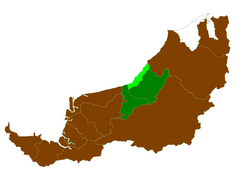Bintulu District
| Bintulu District | ||
|---|---|---|
| District of Sarawak | ||
|
||
 |
||
| District Office location | Bintulu | |
| Local area government (s) | Bintulu Development Authority (BDA) | |
| Government | ||
| • Resident Officer | Haji Ismail Bin Haji Mohd. Hanis | |
| • District Officer | Tuah anak Suni | |
| Area | ||
| • Total | 7,220.40 km2 (2,787.81 sq mi) | |
| Population (2008, estimate) | ||
| • Total | 186,100 | |
| • Density | 26/km2 (67/sq mi) | |
| Ethnicity | ||
| • Iban | 38.3% | |
| • Chinese | 17.9% | |
| • Melanau | 11.4% | |
| • Others | 32.4% | |
The Bintulu District is one of two districts of Bintulu Division in Sarawak, Malaysia. It has a total area of 7,220.40 square kilometres. Bintulu District has a sub-district, which is Sebauh. There are two towns in Bintulu District, namely Bintulu and Sebauh.
The population of Bintulu District (year 2008 estimate) was 186,100. Most of the Bintulu district's population is concentrated at Bintulu proper.
Bintulu is traditionally a home to Iban, Chinese, Melanau, Malay, Orang Ulu and Kedayan people. Most Ibans are scattered throughout rural areas of Bintulu, namely in Tatau and Sebauh. Whilst, Melanau people (or Melanau Bintulu/Vaie people) are concentrated at the town areas in Bintulu and rural communal areas, namely at Bintulu town, Sebauh, Pandan and Labang. Many Malay people are not originally from Bintulu, however, intermarriage with locals especially Melanau people has made Malay as one of the major ethnics in Bintulu. Chinese people are more concentrated at town areas, such as at Bintulu, Sebauh and Tanjung Kidurong, while some resides at Kuala Kebulu and Jelalong. Orang Ulu people, such as Kenyah, Kayan, Tatau, Penan and Punan are more scattered throughout Bintulu district compared to Iban people. Most of them still live deep in the rural areas like Kakus and Jelalong. Kedayan people, although small in number, can be spotted at Nyalau areas (100 km from Bintulu) just at the border with Miri Division.
There is a large influx of foreign worker population due to the strength of the petroleum industry. It was estimated more than 20% of Bintulu population are foreign workers and expatriates.
The economy is largely based on the petroleum and natural gas industries. Bintulu has an estimated 85% of Sarawak’s known natural gas reserves, or some 42.3 trillion cubic feet (1,200 km3). In addition to export as liquified natural gas, on-shore facilities produce fertiliser, and formaldehyde resins. Bintulu also has about half of Sarawak's crude oil reserves of 500 million barrels (79,000,000 m3), with production wells located some 40 kilometers offshore.
...
Wikipedia

